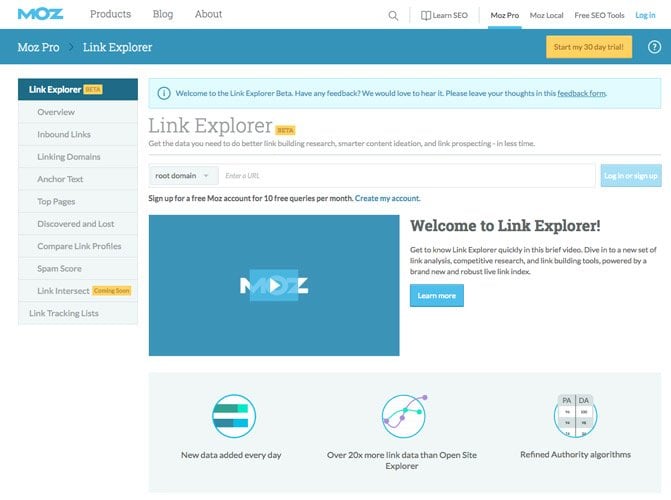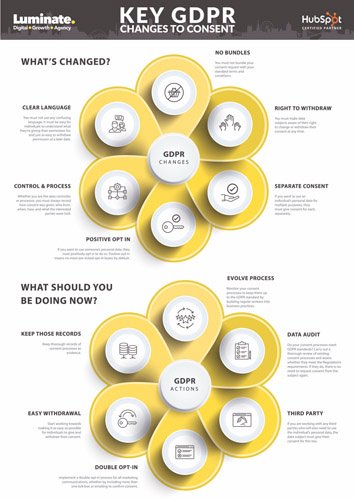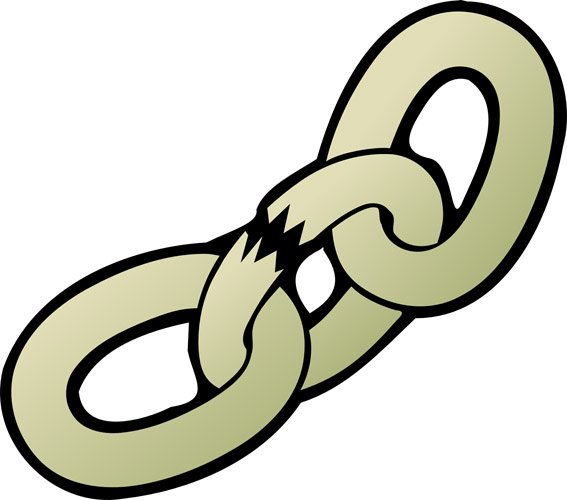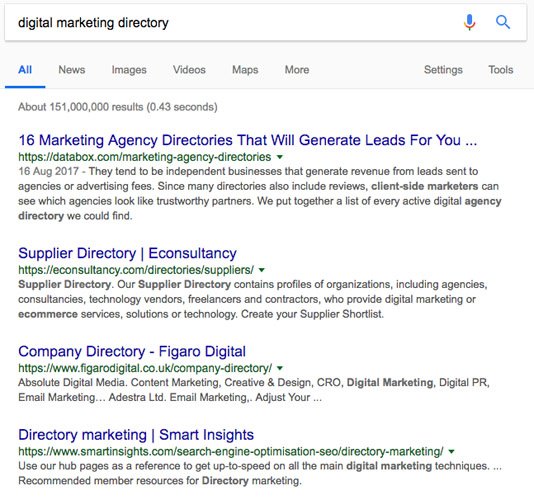What if I told you I could get your site to the very top of Google’s search engine results page (SERP)?
If you’ve ever struggled with ranking on Google, then you’re not the only one. But with years of experience under our belt, we now have the key to help you rank at the very top of the SERPs.
So what is the key?
Backlinks.
According to Moz, backlinks influence your Google rankings more than any other factor. If you can get websites with high domain authorities linking to your site, then your own website’s domain authority increases and all of the pages on your site move up the Google rankings.
To help you achieve this, we’re sharing our 15 expert backlink-building strategies so you can begin to generate high-quality inbound links to your site, increase your domain authority and benefit from more website traffic.
First though...
Some Quick Definitions
Backlinks, also known as inbound links, refer to each time another website links to a piece of your content.
Google uses backlinks when determining the domain authority (DA) of your site. DA is ranked on a 0-100 scoring system and a high domain authority indicates that Google trusts your website to deliver value to its users. So, the higher your DA, the higher you’ll rank on the Google SERP.
It’s as simple as this: The more quality inbound links your site receives, the higher you’ll rank, and the more traffic you’ll benefit from. More traffic means more leads, and more leads mean more money.
Not only that but if you receive a good inbound link and Google bumps up your domain authority, then all of the blogs on your site have the potential to be bumped up the Google rankings.
And hey presto, you’ve just increased your organic traffic. So without further ado, let’s find you some quality backlinks!
1. Target High Domain Authority Websites

It’s very important that you target websites with high domain authority when asking for inbound links.
With link building, it’s all about quality over quantity. Receiving 20 inbound links from lower authority websites will ultimately do very little for your rank, whereas receiving one inbound link from a site with a domain authority of 30 or higher could have your site ranking higher.
As a general rule of thumb, you should only target sites with a domain authority of over 30 for inbound links. You can check a site’s domain authority by using Moz’s Link Explorer. Getting a backlink from a website with a domain authority of less than 30 will virtually have no impact on your Google rankings.
So, aim for websites with a domain authority over 30, and Google will reward you accordingly.
2. Create Fantastic Infographics

Infographics get more social media shares than any other type of content.
It’s easy to see why - people have short attention spans these days, and condensing the information into a neat visual infographic is much more appealing than reading a page full of text.
Bloggers are looking for visual elements that provide value to put into their content. They’re more likely to put a useful and visual infographic in their piece that will help break up their text than link to a blog post that will direct their readers to their site.
You should try to create one high-quality infographic per month, instead of trying to create multiple low-quality ones. Remember, you’re looking for quality over quantity when searching for backlinks, and that starts with your content. Creating a single infographic which contains valuable information and looks great is much more likely to give you lots of inbound links than several lesser-quality infographics.
When it comes to creating infographics, you can’t go wrong with this simple formula:
Good Design + Good Content = A Highly Linkable Infographic
3. Use HARO

HARO, also known as Help A Reporter Out, is an online platform that journalists use to find sources for their articles.
How does this help your backlinking efforts? Well, when a journalist features a source in their article, they almost always include a backlink to that source’s website. I’m sure you can see where we’re going with this...
You can create an account and register as a ‘source’ on the site and then answer journalists’ queries for information. Prove to be a valuable source and journalists will reward you with a backlink in their article.
HARO will inform you of new queries from journalists via email, so keep an eye on your inbox. Journalists work to tight deadlines, so you need to be responding within 10 minutes of the HARO email to ensure you’re one of the very first qualified sources that come their way.
Another great thing about HARO is that news sites generally have high domain authority on Google, so one inbound link from a great news site will increase your own domain authority and get your pages ranking highly!
4. Find Unlinked Mentions of Your Blog

People are forgetful, so it’s possible that someone has written about your brand or service but forgot to link to your website.
But don’t worry! You can turn these mentions into great backlinks. You can set Google alerts to inform you whenever someone mentions your site in their content. When you get an alert, check their page to see if they’ve hyperlinked to your site. If they haven’t, then reach out to the author thanking them for their kind words and asking them to put your site as a source.
Finding unlinked mentions is also a best practice to use with your HARO strategy - after a journalist has used you as a source, you can search to see if they followed through on providing you with a backlink.
This method is simple to use and will get you inbound links with minimal effort. So get Googling!
5. Resurrect Your Dead Backlinks

Sometimes, you’ll find inbound links that already exist on your site but are unfortunately broken.
This error might occur because you changed the location of your page, your site was re-launched or someone misspelt your link online. If a visitor tries to click on your inbound link in any of these cases, it’ll come back with a 404 error.
There are a variety of online tools you can use to check your dead backlinks. One free tool you can use is Broken Link Checker which will highlight broken inbound and outbound links on your site. This is very useful as fixing both these links on your pages will help increase your website’s domain authority.
6. Find Resources Pages With Broken Links

Another way to acquire backlinks is to find resource pages with broken links online and offer to replace them yourself.
It takes three simple steps:
- Google search “[your industry] + resources” to identify multiple resource pages online.
- Download the ‘Check My Links’ plugin on Chrome, which is free. Use the plugin to find these broken links on the resource pages.
- Send emails to the webmasters of these resource pages informing them of their broken links and suggesting your own link as a replacement.
7. Find Businesses That Went Bust

This is another way you can acquire backlinks that takes another three steps:
- Use Google to find competitors that went out of business. It’s also useful to check Wikipedia, which has a list of big businesses that are now bust.
- Use Moz’s Link Explorer to find high-domain authority sites that are still linking to these bust businesses.
- Reach out to the website owners and tell them about the broken links on their site, then suggest your own link as a good replacement.
One defunct business can lead to multiple high-quality links, so don’t waste any time and start finding some backlinks today!
8. Find Your Competitors' Backlinks

You can also use Link Explorer to find any backlinks that your competitors have.
Simply open up Link Explorer, input your competitor’s URL then go to the ‘Inbound Links’ tab. This will show all the pages that link to your competitor’s site. You can then use Link Explorer to check the inbound links of multiple competitors and simply see if they have any sites that are linking to them in common.
If they do, then comes the process of trying to replicate their backlink success and gain your own backlinks from these sites. Your competitors may have a variety of backlinks that include: blog comments, forum posts, guest posts, and so on. So post your own comment, register on a forum and get involved in the discussion, and submit your own guest post.
Doing this will help you uncover great backlinks you wouldn’t have gotten otherwise, and help you understand the complicated backlink-building process even more.
9. Give a Testimonial

Many businesses will offer you the chance to use their product in exchange for talking about your experience, so take advantage of this.
Saying a few words benefits them because it gives them a free testimonial on their site about their product, which helps them build customer trust and enhance their brand image. For you, it’s a great opportunity to get a backlink as thanks and extra traffic from intrigued visitors.
Both of you come out happy, your site benefits from a great backlink and your domain authority increases as well.
A win all around!
10. Collect Testimonials!

On the opposite end, try collecting your own testimonials!
Target bloggers that are well known within your specific industry then reach out to ask if they’re interested in using your product for free, in return for a review. You’ll get some nice exposure for your product and a great backlink from the blogger.
This benefits your domain authority, your Google ranking and your brand all in one go.
11. Write a Great Guest Post

There are also many sites out there that’ll publish guest posts on their blog. Find a website with a high enough domain authority and the time it takes to write a guest blog more than pays for itself in backlink value.
However, there are a few things to keep in mind:
- Reach out and write guest posts on sites relevant to your industry and blog topics.
- Quality is key. A poorly written article will be less likely to be picked up as a guest blog, so don’t skimp on quality. Focus on making your content interesting and high quality, and the rest will fall into place.
- Don’t be biased or overly promote your company or service. Remember, quality and providing value to the site hosting you and your audience is key. A great article will bring visitors to your site, but forcing a message onto them that they’re not ready for will not.
So write a guest post, and they’ll give you one in return.
12. Stats, Stats, Stats

Everyone loves stats!
In fact, after infographics, creating statistic posts is one of the most effective passive link-building techniques out there.
Reporters and bloggers use Google to find stats to use in their articles, and if your high-quality post appears in their search results, you can bet they’re going to use you as a source. The more people using your stats post, the more potential for backlinks. If you can gather a few from high domain authority websites, you’ll see your site skyrocketing up those Google rankings.
Here are a few tips:
- List your stats using bullet points. This makes your post easy to scan and pick out specific stats, which reporters will love.
- Update your existing statistic posts. No one’s going to read a post centred around 2016 statistics, so make sure you keep up to date!
- Optimise your blog title for Google. Your title is the first thing reporters and bloggers see, so it has to stand out. We’re not going to go into the details of how you do this now, but you can learn more on our blog: 9 Ultimate Title Tag Best Practices to Skyrocket Your SEO Ranking.
13. List Posts
Guess what?
- People
- Love
- Lists
- Too
According to Moz, blog posts that use the list formula and include videos and images receive more backlinks than any other type of post. So, start loving list posts!
Here are a few tips to help you:
Embed YouTube videos and tweets
It’s great to include a variety of mediums in your posts as they break up the text and make it much more scannable and appealing to read.
Embedding videos and tweets also make people stay on your page longer to view them, which increases average dwell time and contributes positively to your Google ranking. To see how you could increase your dwell time using some key techniques, check out our blog post on the subject.
Include graphs and charts
People love graphs and charts just as much as they love statistics - they’re a great source of information and make your blog look much more professional and valuable. They’re also very easy to share, and, as a result, are very easy to receive backlinks for.
14. Use Trustworthy Directories

Posting a link to your website on online directories is a great way of getting others to post links to your site too.
But you must be careful. There are tons of online directories that are filled with junk, which Google has appropriately excluded from its search results. You don’t want your site listed on those pages as that can negatively affect your rank.
Instead, aim for directories attached to informative websites for specific industries. For example, you could use Yelp if you operate in the service industry. Having your website listed in those directories will help people find you online and drive organic traffic to your site. Once they’ve visited your website, you can increase the chance that they’ll link to your site in their own blog posts by providing valuable and timely content.
A win-win for everyone!
15. Podcast Interviews

Podcasters are always looking for people they can interview on their shows.
So, Google some podcasters relevant to your industry and reach out offering to be on their show. Try to pick podcasters with a good reputation and a solid audience, and in return, you’ll get a backlink in their show notes and extra exposure for your brand.
Well-established podcasters will also have high domain authority sites, which once again, gives you a very high-quality backlink.
Prepare for your interview properly, dazzle with your expertise and the rest will fall into place.
Creating high-quality backlinks to your website is very important for your SERP ranking. However, it’s only one element among many that make up an SEO strategy that increases organic traffic and gets more visitors coming to your site.




